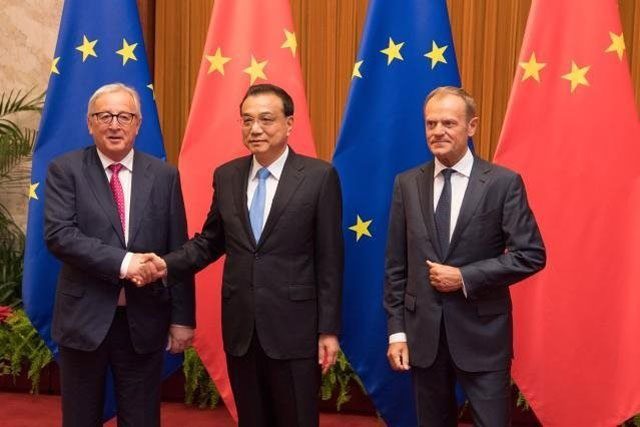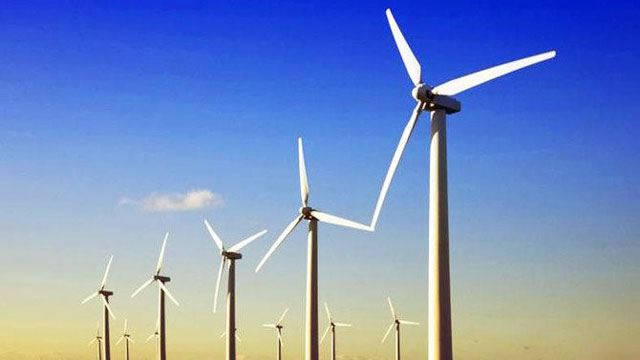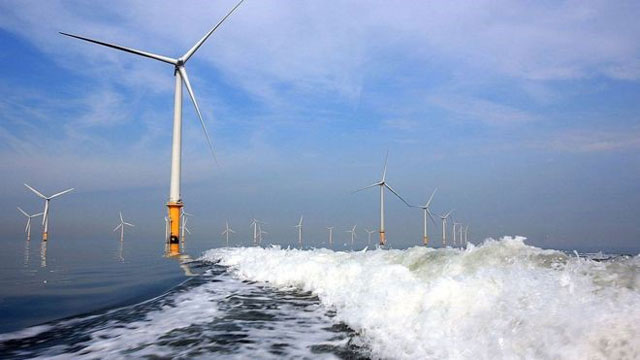
As one of Turkey’s outstanding provinces in terms of the number of sunny days, Van has started to attract investments in solar power – which will brighten the city’s future.
Halil Ibrahim Guray, general secretary of the Eastern Anatolia Development Agency, told that having 3 thousand hours of sunshine in a year, Van ranks first in Turkey in terms of technical, geographical and climate conditions, power generation efficiency and appropriate land for solar installments.
Turkey's Akfen Holding will build a solar power plant with 30 megawatts (MW) of total installed capacity in Turkey's eastern province of Van.
The $55 million solar power plant will be located in the Edremit district of Van. The plant, which will be built on a 600 thousand square meter site, will have a 20 MW of electricity generating capacity in September and the installation of the remaining 10 MW capacity will be finalized next year, Guray said.
Guray added that the power plant, when fully operational, will produce 59.7 gigawatt-hours of electricity annually and will provide electricity for about 30 thousand households in the region.
Source: Akfen

Turkey’s maritime jurisdiction has resurfaced on the agenda as a power struggle regarding energy reserves in the eastern Mediterranean continue. It is claimed that there are natural gas reserves in Turkey’s maritime jurisdiction that could meet 572 years’ worth of the country’s energy needs.
Greece, which seeks control of energy deposits of the eastern Mediterranean, is trying to draw sea borders via Libya and Crete. Meanwhile, the Greek Cypriot administration is negotiating with Egypt and Israel.
According to Dr. Cihat Yaycı’s “The Issue of Sharing Marine Jurisdiction in the eastern Mediterranean and Turkey,” this region boasts rich energy resources.
Considering the size of the total hydrocarbon deposits in the eastern Mediterranean, Dr. Yaycı emphasized that it would be sufficient to meet 572 years’ worth of Turkey's natural gas needs. According to Turkish Petroleum Corporation (TPAO) estimates, the eastern Mediterranean is also rich in gas hydrate deposits, which have been dubbed as the energy of the future.
Turkey boosts efforts to protect eastern Mediterranean
Greece is trying strike a deal with the Greek Cypriot administration. In some maps published by Israel, the Greek Exclusive Economic Zone is shown as the continuation of South Cyprus. However, Turkey has increased its efforts in the face of this cooperation. It recently halted Italian ships who sought to conduct drilling in the Turkish Republic of Cyprus with warships. South Cyprus is attempting to sign an agreement with Egypt and Libya over oil exploration sites it has set up in the main land state of Egypt and Israel, which accepted the deal despite incurring losses in order to spite Turkey.
Eastern Mediterranean gas deposits worth $3 trillion
Expert findings indicate that there is a natural gas deposit in the eastern Mediterranean with a total value of $3 trillion. The U.S. Geological Survey Center estimates that there are 3.45 trillion cubic meters of natural gas and 1.7 billion barrels of oil in the Levant Basin, which lies between Cyprus, Lebanon, Syria and Israel.
It is estimated that about 1.8 billion barrels of oil, 6.3 trillion cubic meters of natural gas and 6 billion barrels of liquid natural gas are located in the Nile Delta Basin. Apart from the 8 billion barrels of oil that is thought to be found around Cyprus Island, the south of Crete, called Heredot, is estimated to have 3.5 trillion cubic meters of natural gas.
Source: Yeni Safak

According to the latest report of the International Gas Union (IGU), Turkey became the second largest liquefied natural gas (LNG) importer country in Europe in 2017.
According to the report, new sources of natural gas from conventional and unconventional deposits, in combination with new and existing pipelines, and the rapid growth of Liquefied Natural Gas (LNG) infrastructure, are greatly enhancing supply security, flexibility, and affordability.
According to statistics compiled from the report, European countries imported 47 million tons of LNG in total in 2017. Spain was the leading country in LNG imports in Europe with 12.2 million tons per year.
Turkey imported 7.8 million tons of LNG last year. France followed Turkey with 6 million tons and the U.K. imported 4.9 million tons. Turkey was the third biggest LNG importer in 2015 and fourth biggest in Europe in 2016 with 5.6 million tons per year.
African and Middle Eastern countries supplied the majority of Europe's LNG. Turkey imported 3.45 million tons of LNG from Algeria, 1.51 million tons from Nigeria and one million tons from Qatar. Other countries that sold LNG to Turkey were Norway, Trinidad & Tobago and the U.S.
Turkey's Energy and Natural Resources Ministry aims to increase its natural gas storage capacity and the number of LNG facilities in the country. The country has its Marmara Ereglisi LNG Terminal with a capacity of 5.9 million tons and the Aliaga Egegaz LNG Terminal with 4.4 million tons of capacity per annum.
Turkey also has two floating storage and regasification units (FSRUs), one of which is located in Izmir and the other in Hatay. The country plans a third FSRU in the Saros Bay, north of the Gallipoli Peninsula in northwestern Turkey. In addition, Spain, which does not have an FSRU, has LNG terminals located in Barcelona, Huelva, Cartagena, Bilbao, Sagunto, Mugardos and El Musel.
Source: IGU

Turkey's refinery giant TUPRAS plans to open an office in London to expand trade operations, the company announced Wednesday. The decision was taken following the company's close evaluation of market opportunities in the context of its aim to expand trade and based on similar moves taken in the market, TUPRAS said.
With the establishment of the London office, the company aims to develop import and export activities and generate further income from expanding its supply and sales chain. Preparations for the London office are expected to be completed by the end of the year, the company added.
TUPRAS is Turkey’s largest industrial enterprise and Europe’s seventh biggest refining company. It topped Fortune 500 list for Turkey with net sales revenue of 53.9 billion Turkish liras ($14.8 billion) in 2017. The company has four refineries in Turkey including Izmir, Kocaeli, Kirikkale and Batman with a total crude oil processing capacity of 28.1 million tons per year. It has a 60 percent share in Turkey’s total petroleum fuel products market consisting of gasoline, diesel, fuel oil and jet fuel.
Source: AA

A China-EU Summit held on Monday resulted in the signing of a joint statement between the two economic powers on climate change and clean energy, which reaffirms their respective commitment to the Paris Climate Agreement and to intensify their cooperation on climate change and clean energy.
Relations between China and the European Union have not always been smooth when it comes to their cooperation (or lack thereof) on climate change and clean energy, as was highlighted the last time these two powers met in June of 2017, when talks collapsed after the text of their proposed joint climate statement was leaked.
However, the text of the “Leaders’ Statement on Climate Change and Clean Energy” which was signed in Beijing on July 16 between the President of the European Commission Jean-Claude Juncker, the President of the Council, Donald Tusk, and the Chinese Prime Minister Li Keqiang, is almost identical, suggesting that the shifting global political landscape — driven primarily by the actions of US President Donald Trump — have been able to smooth over whatever bumps were evident last time around.
In addition to the Leaders’ Statement, Commission Vice-President Jyrki Katainen and the Chinese Minister of Ecology and Environment Li Ganjie signed a Memorandum of Understanding that will see the two powers increase their cooperation on emissions trading.
“We have underlined our joint, strong determination to fight climate change and demonstrate global leadership,” said President of the European Commission Jean-Claude Juncker, welcome the signing. “It shows our commitment to multilateralism and recognises that climate change is a global challenge affecting all countries on earth. There is no time for us to sit back and watch passively. Now is the time for decisive action.”
In addition to a joint statement summarizing the entirety of discussions between the EU and China — which comes in at 3,500 words and 8 pages in length, runs to 44 separate points of agreement and praise, and only gets to their joint commitments on climate change and clean energy by point 28 — the two powers also published the Leaders’ Statement on Climate Change and Clean Energy (PDF) which itself runs to 8 pages and 15 points (plus annex). And while the text is nearly identical to that of the one dumped last year, their willingness to publish a statement that leads with the following is telling:
“The EU and China consider climate action and the clean energy transition an imperative more important than ever. They confirm their commitments under the historic 2015 Paris Agreement and step up their co-operation to enhance its implementation.”
The new Statement builds on from previous agreements made between the two powers — the EU-China Joint Statement on Climate Change in 2015 and the EU-China Roadmap on Energy Cooperation in 2016 — to “significantly intensify their political, technical, economic and scientific cooperation on climate change and clean energy, in view of the necessary world-wide transformation to a resource efficient, sustainable, low greenhouse gas emission and climate resilient economy and society, in the context of sustainable development and poverty eradication.”
Unlike some statements that have been made in the past 18 months by supranational bodies and institutions or summits, no mention was made of the United States’ decision to abrogate its responsibility to the Paris Agreement or its current President’s seemingly-willful intentions to act contrary to the otherwise-unanimous action of the global community regarding climate change and clean energy. This is either unsurprising or telling, and more likely a little of both, considering the current tension that already exists between both the EU and China with the United States.
“This climate statement reaffirms the resolve of Beijing and Brussels to take the Paris Agreement forward in this crucial year for climate diplomacy,” said Tara Connolly, EU Climate and Energy Policy Director for Greenpeace. “China and the EU understand the opportunities offered by a clean and climate safe world.
“As climate impacts start to bite across the world, the need to act on climate change is more urgent than ever. To demonstrate their alignment is more than just a marriage of convenience and to show a genuine will to lead, both sides must enhance their climate targets for 2030. This statement should be the first step in that direction.”
Source: Cleantechnica

Saudi Arabia has received bids from four consortiums competing to win a contract for the $500 million Dumat Al Jandal project — the Kingdom’s first utility-scale wind farm.
The project is due to be awarded on Dec. 18, according to a government announcement on Monday. It will be backed by a 20-year power purchase agreement with the Saudi Power Procurement Company.
The 400MW wind farm will be built in the northern Al-Jouf region and is part of wider efforts to increase the proportion of renewable energy the country produces to help diversify the economy away from its reliance on oil.
“The Kingdom’s first utility-scale wind project opens a new chapter in our journey toward a diversified energy mix. The development of a wind energy industry in Saudi Arabia is an important component of our wider industrial diversification strategy,” said Khalid Al-Falih, minister of energy, industry and mineral resources.
The tender is the second to be issued by the ministry under the National Renewable Energy Program, a government strategy which sets out specific targets on future renewable energy production.
The program aims to increase the country’s renewable energy share to 3.45 GW by 2020 — the equivalent of 4 percent of total energy production. By 2023, this proportion is expected to increase to 9.5 GW, the equivalent of 10 percent of total production.
Once complete, the wind farm will be able to generate enough power to supply up to 70,000 Saudi households, the ministry said.
The bids were received from companies already pre-qualified following the issuing of a request for proposal in August last year.
France’s EDF Energies Nouvelles and Abu Dhabi’s Masdar placed the lowest bid of just under eight halalas per kilowatt hour, while the second lowest was submitted by the Dubai branch of France’s Engie and Saudi Services for Electro Mechanic Works.
A halala is equal to one hundredth of a riyal. A consortium of Saudi Arabia’s ACWA Power and Portugal’s Martifer Renewables placed a bid of slightly over 10 halalas per kilowatt hour, while Italy’s Enel Green Power and local firm Al Babtain Contracting bid just over 12 halalas.
Source: Arab News

The UK's offshore wind power capacity is set to nearly double over the next decade, as a result of a new government initiative, according to the industry. It said that by 2030, between a fifth and a third of the UK's electricity could come from offshore wind power. Thanks to plummeting costs, offshore wind has become an increasingly affordable source of clean energy.
The UK has cut costs for consumers with a system which forces firms to bid for financial support in auctions. The Climate and Energy Secretary, Claire Perry, confirmed on Monday that these auctions would be held every two years to give the industry the stability it needed to continue to build the huge structures that tower over the waves.
At the auctions, energy firms bid for contracts that guarantee a minimum price for the power they will sell. The auction process has forced firms to be transparent about the amount of support they actually need and has halved the cost of supporting offshore wind.
The system has been adopted worldwide and is recognized as a major UK contribution to the development of clean energy. Renewable UK's chief executive, Hugh McNeal, said: "This sets us on the path to deliver the tens of billions of pounds of investment that will be needed to meet our ambition of at least 30GW by 2030.
"We can look forward to a pipeline of new offshore wind projects that will support tens of thousands of jobs across the UK."
'Confusing and irrational'
The initiative was generally welcomed by environmental groups, but they said the ascent of offshore wind called into question the government's continuing support for nuclear power, which will be much more expensive. Kate Blagojevic from Greenpeace said: "Onshore wind is also getting cheaper all the time and is now the UK's cheapest electricity source.
"Solar has been dropping for so long that it has actually reduced in cost by an astonishing 99% since the technology was commercialized. "This makes the government's huge financial support for nuclear, the one low carbon source which keeps going up and up in price, all the more confusing and irrational."
The government insists it needs a diversity of power supply.
Source: BBC

A newly identified group of materials could help recharge batteries faster, raising the possibility of smartphones that charge fully in minutes and accelerating the adoption of major clean technologies like electric cars and solar energy, say researchers.
The speed at which a battery can be charged depends partly upon the rate at which positively charged particles, called lithium ions, can move towards a negatively charged electrode where they are then stored. A limiting factor in making “super” batteries that charge rapidly is the speed at which these lithium ions migrate, usually through ceramic materials.
One potential solution is to make everything much smaller, by making batteries with nanoparticles. But nanoparticles are expensive and tricky to make and so scientists have been searching for alternative materials to circumvent this problem. Now, researchers at the University of Cambridge have identified a group of materials called niobium tungsten oxides through which lithium ions can move at astonishingly high rates, meaning much faster charging batteries.
“Niobium tungsten oxides are fundamentally different,” said Kent Griffith, first author on the study published in the journal Nature. First discovered in 1965, these materials have a rigid, open structure and have larger particle sizes than many other materials commonly used in batteries.
Now, researchers at the University of Cambridge have identified a group of materials called niobium tungsten oxides through which lithium ions can move at astonishingly high rates, meaning much faster charging batteries.
“Niobium tungsten oxides are fundamentally different,” said Kent Griffith, first author on the study published in the journal Nature. First discovered in 1965, these materials have a rigid, open structure and have larger particle sizes than many other materials commonly used in batteries.
Another advantage of these alternative materials is that they are cheap and straightforward to make. “These oxides are easy to make and don’t require additional chemicals or solvents,” said Griffith. Electric cars and grid-scale storage for solar power are two environmentally friendly technologies that could be revolutionized by better batteries.
Clare Grey, professor of materials chemistry at the University of Cambridge and senior author on the paper, said the next step will be to optimize the use of this material in a full battery, which can be cycled for the time and length needed for electric vehicles. “For example, electric buses where you may want to charge the bus very fast at the bus stop,” she added.
“The discovery is very exciting in terms of what it does for battery performance,” said Dan Brett, professor of electrochemical engineering at University College London, who was not involved in the work. “The really clever thing about the work is the insight into the mechanism and ability to measure how fast the lithium ions travel through the material.”
Brett added: “This technique will also allow these materials to be further optimized, so we can look forward to future improvements in [battery] power, energy and lifetime.”
Source: The Guardian
Customer Engagement in an Era of Energy Transformation by PwC
Technology is eclipsing competition as the biggest single transformational force affecting customer relations for power utility companies. It’s shifting customer expectations of what to expect from companies. The online experiences customers are becoming used to in areas such as retailing, travel and media are setting a new norm, raising the standards expected for baseline aspects of a utility’s operations such as metering, billing, payment and outages. And, when combined with developments in device and building automation as well as energy management, this is opening up new opportunities for customer service, added value and new business streams.
Please click here to read the full report.
Agenda
Global Power & Energy Exhibition 2018
September 17 – 20 / Barcelona, Spain
Global District Energy Days
September 25 - 27 / Helsinki, Finland
Global Wind Summit
September 25 – 28 / Hamburg, Germany
11th International Conference on Energy and Climate Change
October 10 – 12 / Athens, Greece
